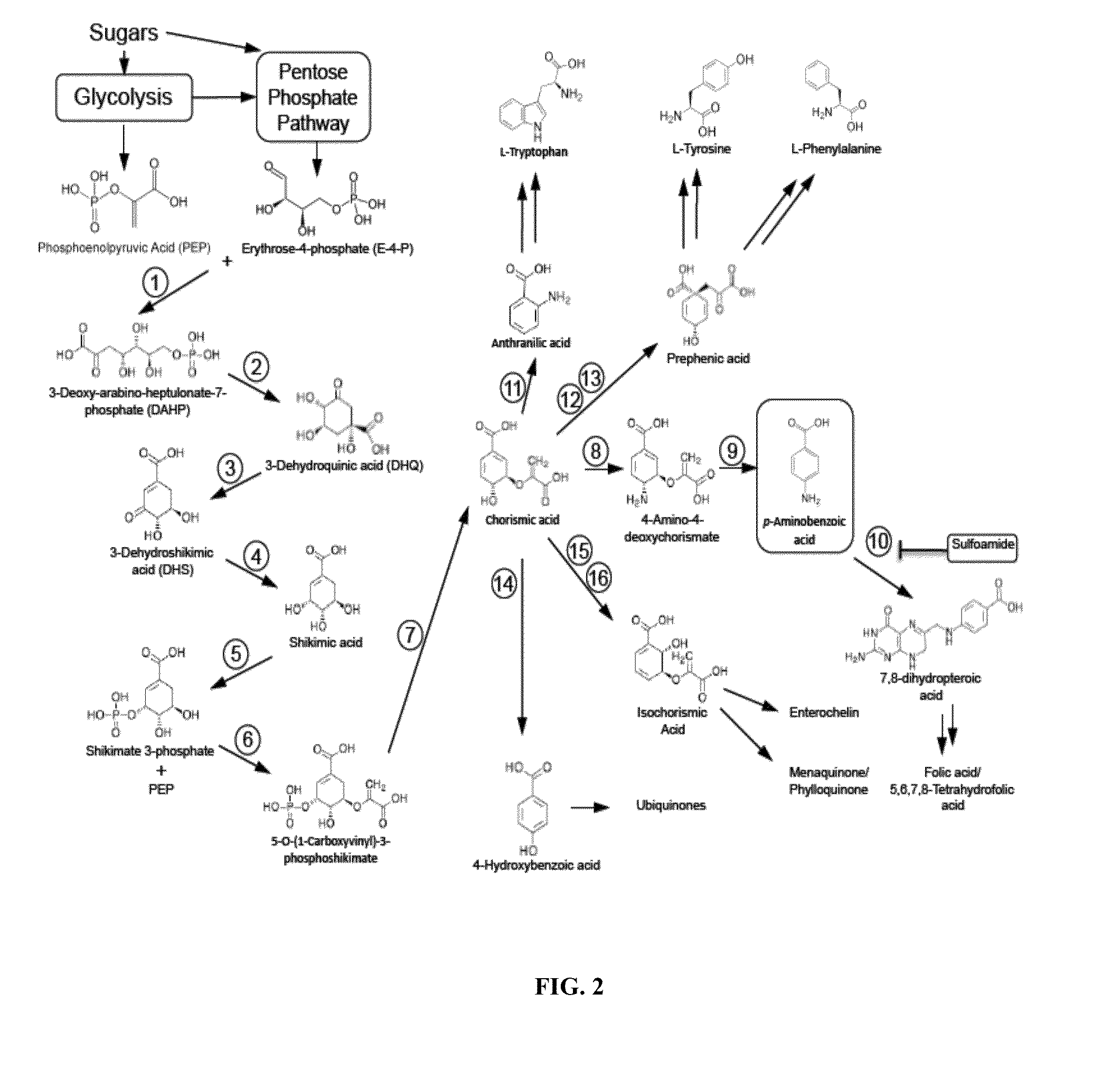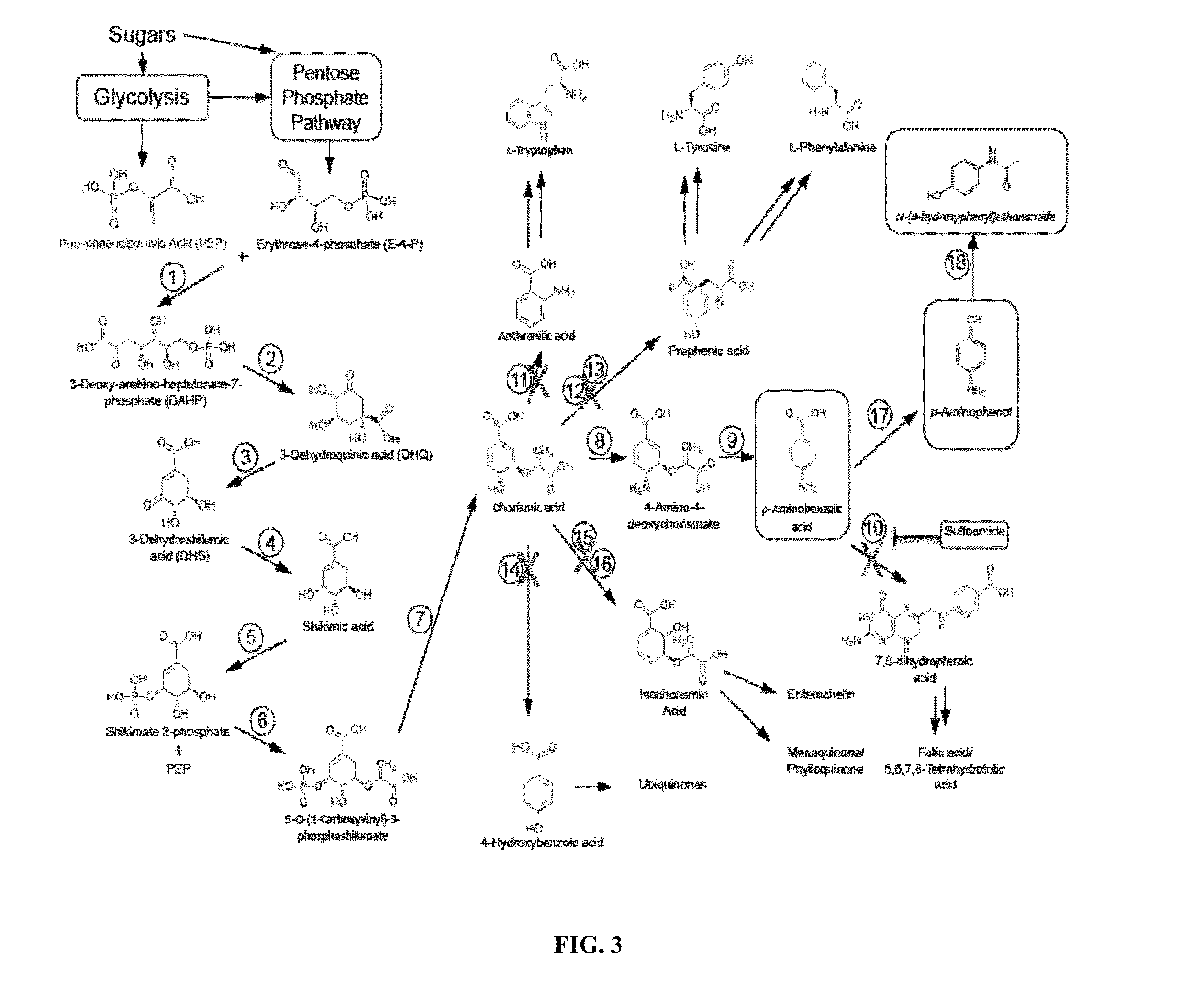Biological synthesis of p-aminobenzoic acid, p-aminophenol, n-(4-hydroxyphenyl)ethanamide and derivatives thereof
a technology of p-aminobenzoic acid and p-aminophenol, which is applied in the field of biological engineering of microorganisms and production of chemical compounds, can solve the problems of reducing yield, high production cost of chemicals, and no renewable or biologically derived source of paba available commercially
- Summary
- Abstract
- Description
- Claims
- Application Information
AI Technical Summary
Benefits of technology
Problems solved by technology
Method used
Image
Examples
example 1
[0214]0.1 g of 5% Ru / Al2O3, 1.0 g of PABA, and 30 mL of DI water are placed in 75 mL high pressure Parr reactor. The reactor is sealed and then pressurized to 200 psi by H2. The reactor is heated up to 200° C., and the temperature is maintained for 1 hour. The reaction product is obtained after the temperature reached room temperature. The aminophenol is isolated, and placed in the 75 mL high pressure Parr reactor with 0.1 g of 5% Ru / Al2O3 and 30 mL of DI water. The reactor is sealed and then pressurized, first, to 50 psi by NH3 and to 200 psi by H2. The reactor is heated up to 200° C., and the temperature is maintained for 1 hour. The reaction product is collected after the temperature reaches room temperature and analyzed by HPLC and GC.
example 2-7
[0215]Experiments with Raney, Cu, CuCr, Raney Ni, Ru or Pd catalyst with different solvents, different temperature and pressure is carried out in the same manner as described in Example 1. The results are shown in Table 2.
TABLE 2Example 2-7ExampleCatalyst 1Catalyst 2Solvent2Raney CuRaney NiH2O3CuCrRaney NiH2O4RuRuH2O5RuRuTHF6PdPdH2O7PdPdTHF
example 8-15
[0216]This example demonstrates experiments to catalytically convert PAP to PPD. In a typical experiment, 0.1 g of catalyst, 1.0 g of PAP, and 30 mL of solvent are placed in 75 mL high pressure Parr reactor. The reactor is sealed and then pressurized, first, with NH3. The reaction was then pressurized with H2 for reactions using both gases. The reactor is heated up to the target temperature and the temperature is maintained for 0.5 hour. The reaction product is obtained after the temperature reached room temperature. Analysis of the products is conducted by HPLC and GC. The example surveys multiple catalysts and conditions and the results are shown in Table 3.
TABLE 3Example 8 Experiments to Convert PAP to PPDExpt.Sub-ReactantTempPressure#strateCatalystSolventGas(° C.)(NH3 / H2, psi)8PAPRaNiH2ONH315075 / 300PAPRaNiH2ONH315075 / 500PAPRaNiH2ONH330075 / 300PAPRaNiH2ONH330075 / 5009PAPRaNiH2ONH3 / H215075 / 300PAPRaNiH2ONH3 / H215075 / 500PAPRaNiH2ONH3 / H230075 / 300PAPRaNiH2ONH3 / H230075 / 50010PAPRu / Al2O3H2O...
PUM
| Property | Measurement | Unit |
|---|---|---|
| orientation angle | aaaaa | aaaaa |
| temperature | aaaaa | aaaaa |
| pressure | aaaaa | aaaaa |
Abstract
Description
Claims
Application Information
 Login to View More
Login to View More - R&D
- Intellectual Property
- Life Sciences
- Materials
- Tech Scout
- Unparalleled Data Quality
- Higher Quality Content
- 60% Fewer Hallucinations
Browse by: Latest US Patents, China's latest patents, Technical Efficacy Thesaurus, Application Domain, Technology Topic, Popular Technical Reports.
© 2025 PatSnap. All rights reserved.Legal|Privacy policy|Modern Slavery Act Transparency Statement|Sitemap|About US| Contact US: help@patsnap.com



